Lexus LC500C (2022 year). Manual in english — page 21
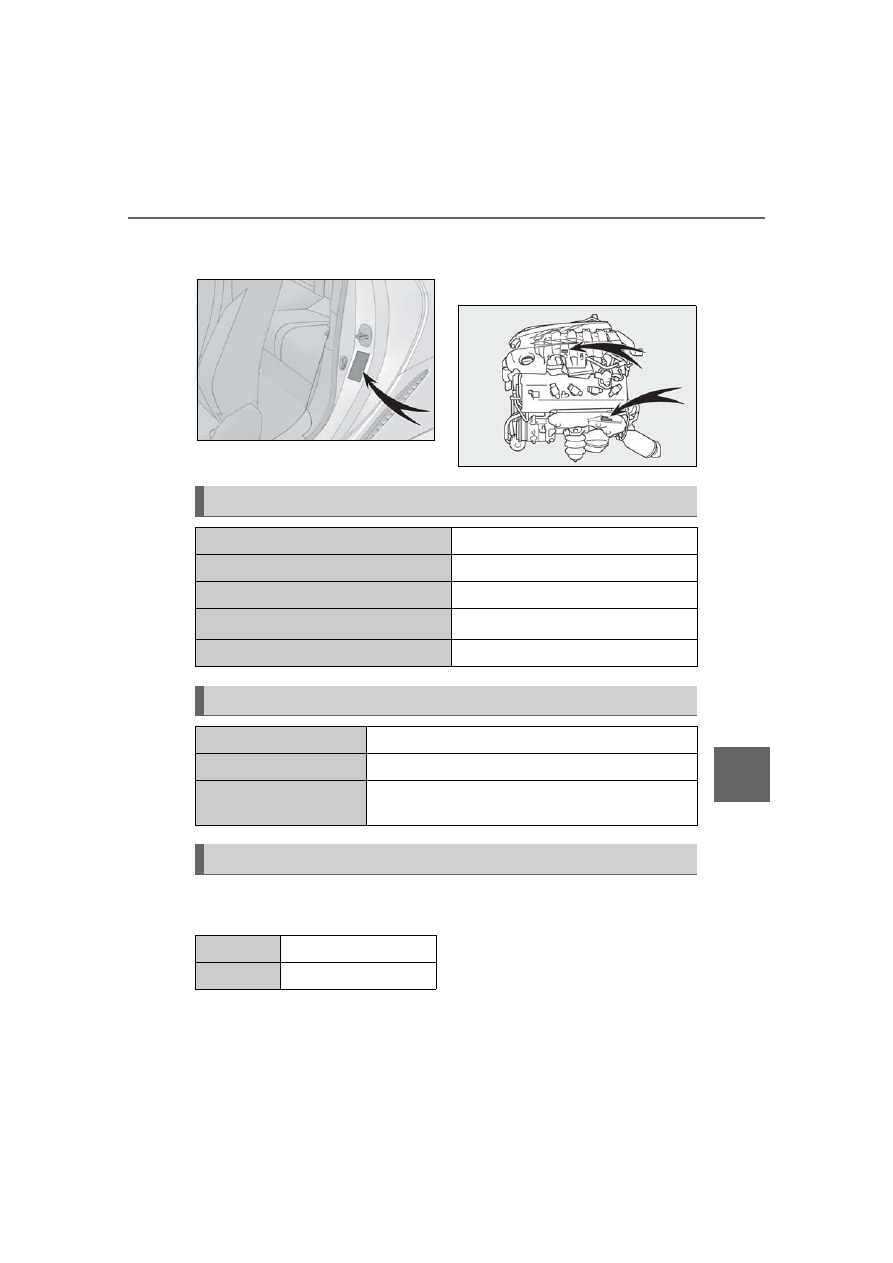
347
8-1. Specifications
8
Vehi
cle
spec
ifi
ca
tions
This number is also on the Certification
Label.
■
Engine number
The engine number is located as
shown.
■
Oil capacity (Drain and refill [Ref-
erence
*
])
*
: The engine oil capacity is a reference
quantity to be used when changing the
engine oil. Warm up and turn off the
engine, wait more than 5 minutes, and
check the oil level on the dipstick.
■
Engine oil selection
“Toyota Genuine Motor Oil” is used in
your Lexus vehicle. Use Lexus
approved “Toyota Genuine Motor
Engine
Model
5.0 L 8-cylinder (2UR-GSE) engine
Type
8-cylinder V type, 4-cycle, gasoline
Bore and stroke
3.70
3.52 in. (94.0
89.5 mm)
Displacement
303.2 cu.in. (4969 cm
3
)
Drive belt tension
Automatic adjustment
Fuel
Fuel type
Unleaded gasoline only
Octane Rating
91 (Research Octane Number 96) or higher
Fuel tank capacity (Refer-
ence)
21.7 gal. (82.0 L, 18.0 Imp.gal.)
Lubrication system
With filter
9.1 qt. (8.6 L, 7.6 Imp.qt.)
Without filter 8.4 qt. (7.9 L, 7.0 Imp.qt.)
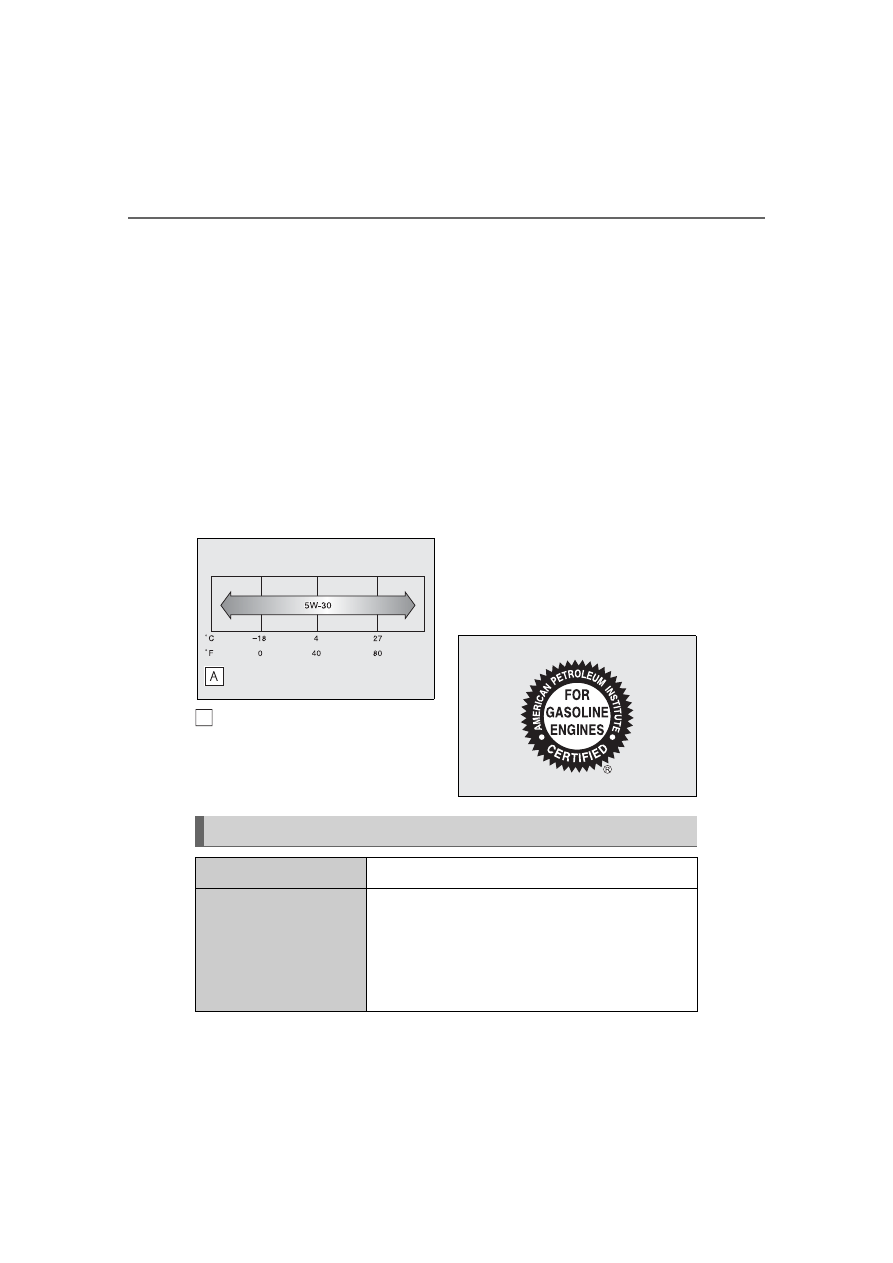
348
8-1. Specifications
Oil” or equivalent to satisfy the follow-
ing grade and viscosity.
Oil grade:
ILSAC GF-6A multigrade engine oil
Recommended viscosity:
SAE 5W-30
SAE 5W-30 is the best choice for
good fuel economy and good starting
in cold weather.
If SAE 5W-30 is not available, SAE
10W-30 oil may be used. However, it
should be replaced with SAE 5W-30
at the next oil change.
Outside temperature
Oil viscosity (5W-30 is explained here
as an example):
• The 5W in 5W-30 indicates the
characteristic of the oil which allows
cold startability. Oils with a lower
value before the W allow for easier
starting of the engine in cold
weather.
• The 30 in 5W-30 indicates the vis-
cosity characteristic of the oil when
the oil is at high temperature. An oil
with a higher viscosity (one with a
higher value) may be better suited if
the vehicle is operated at high
speeds, or under extreme load con-
ditions.
How to read oil container label:
The International Lubricant Specifica-
tion Advisory Committee (ILSAC)
Certification Mark is added to some oil
containers to help you select the oil
you should use.
*
: The fluid capacity is a reference quantity.
A
Cooling system
Capacity
*
12.8 qt. (12.1 L, 10.6 Imp.qt.)
Coolant type
Use either of the following:
“Toyota Super Long Life Coolant”
Similar high-quality ethylene glycol-based non-silicate,
non-amine, non-nitrite, and non-borate coolant with
long-life hybrid organic acid technology
Do not use plain water alone.
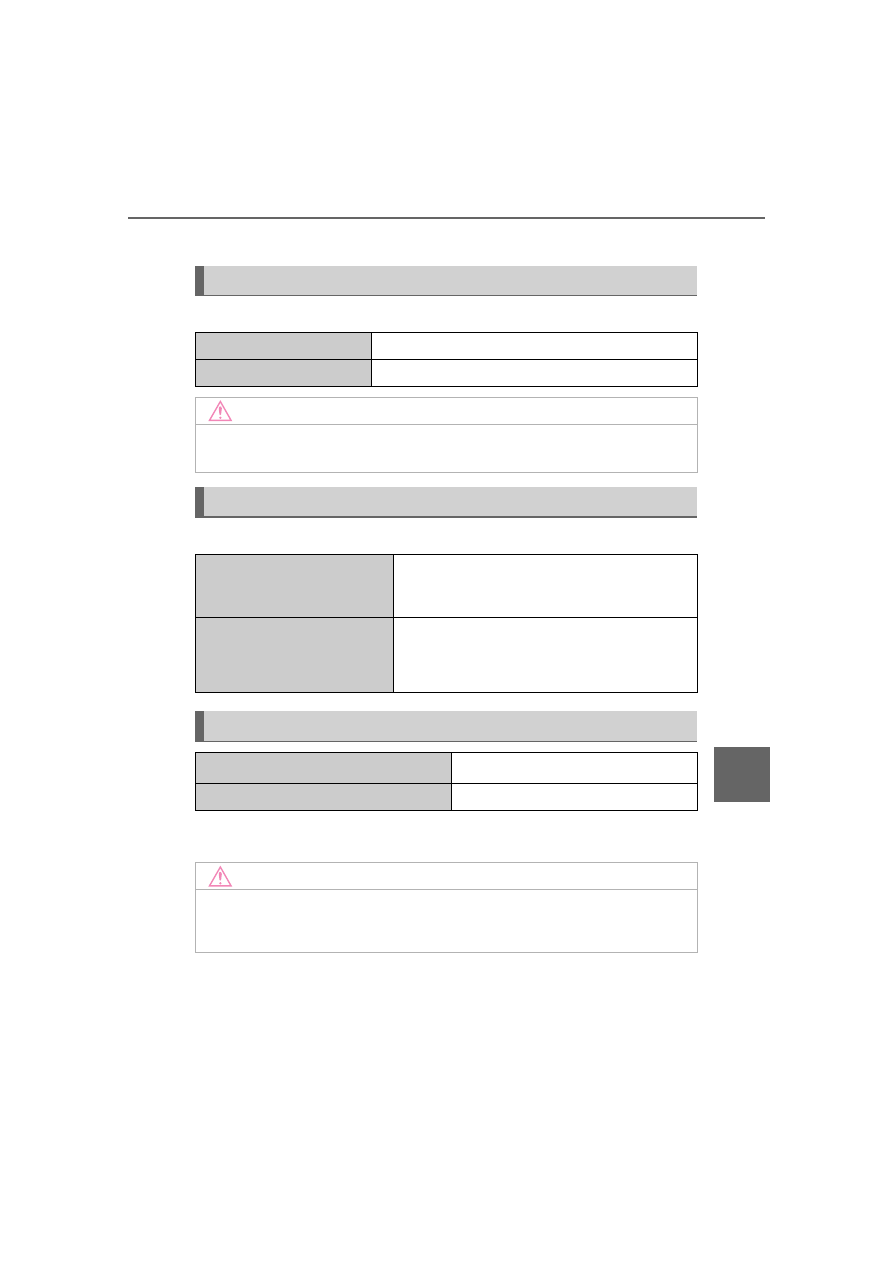
349
8-1. Specifications
8
Vehi
cle
spec
ifi
ca
tions
If replacement is necessary, contact your Lexus dealer.
■
Spark plug
■
Battery
*
: The fluid capacity is a reference quantity.
If replacement is necessary, contact your Lexus dealer.
Ignition system
Make
DENSO FK20HBR-J8
Gap
0.031 in. (0.8 mm)
NOTICE
■
Iridium-tipped spark plugs
Use only iridium-tipped spark plugs. Do not adjust the spark plug gap.
Electrical system
Open voltage at 68°F (20°C):
12.3 V or higher
(Turn the engine switch OFF and turn on the head-
lights for 20 to 30 seconds.)
Charging rates
Quick charge
Slow charge
15 A max.
5 A max.
Automatic transmission
Fluid capacity
*
9.3 qt. (8.8 L, 7.7 Imp.qt.)
Fluid type
Toyota Genuine ATF WS
NOTICE
■
Automatic transmission fluid type
Using transmission fluid other than the above type may cause abnormal noise or vibra-
tion, or damage the transmission of your vehicle.
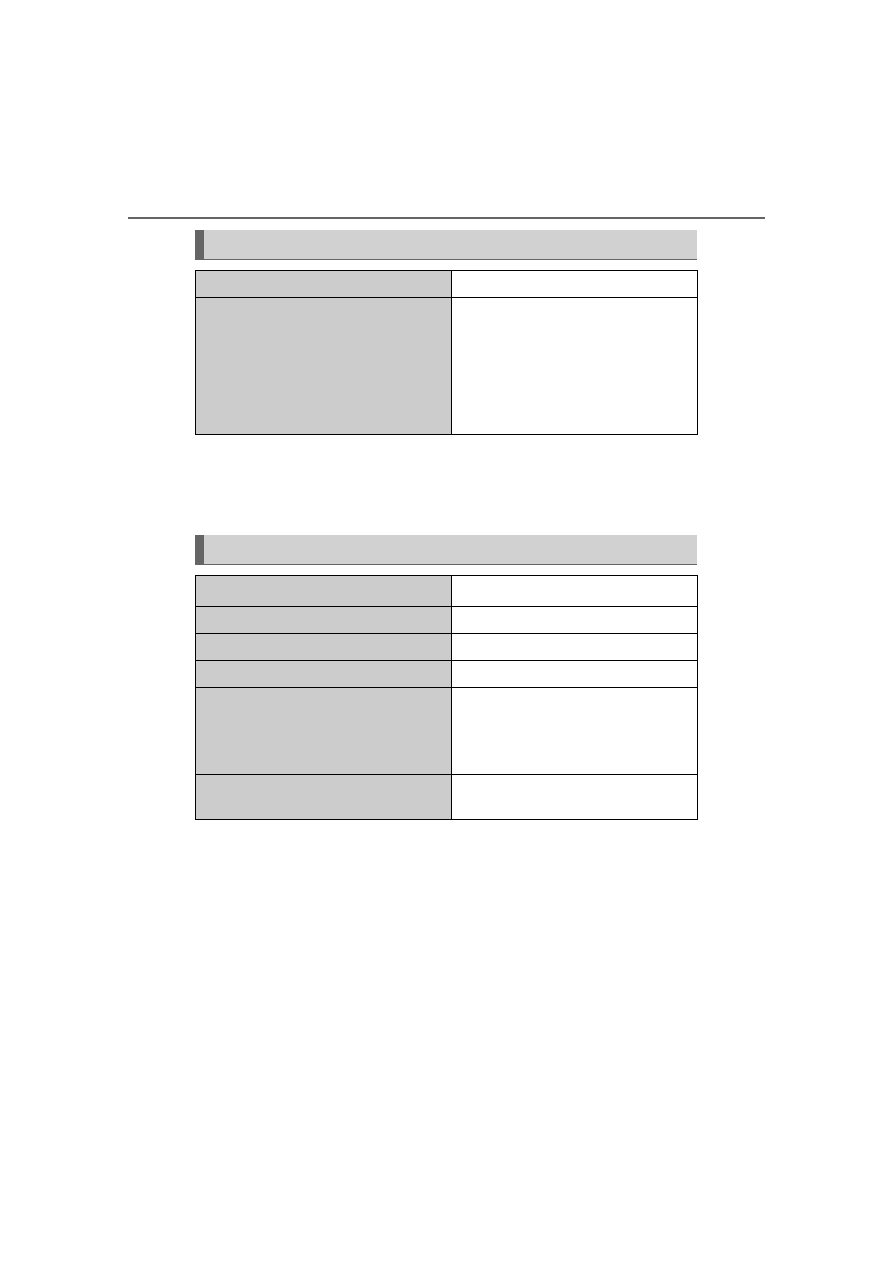
350
8-1. Specifications
*
: Your Lexus vehicle is filled with “Toyota Genuine Differential Gear Oil” at the factory.
Use Lexus approved “Toyota Genuine Differential Gear Oil” or an equivalent of match-
ing quality to satisfy the above specification. Please contact your Lexus dealer for further
details.
*1
: Minimum pedal clearance when depressed with a force of 112.4 lbf (500 N, 51.0 kgf)
while the engine is running.
When performing the brake pedal inspection, also be sure to check that the brake sys-
tem warning light is not illuminated when the engine is running. (If the brake system
warning light is illuminated, refer to P.308.)
*2
: Make sure to confirm that the brake system warning light (yellow) does not illuminate. (If
the brake system warning light illuminates, refer to P.312.)
Differential
Oil capacity
0.90 qt. (0.85 L, 0.75 Imp.qt.)
Oil type and viscosity
Without LSD (Limited Slip Differential)
Toyota Genuine Differential gear oil LT
75W-85 GL-5 or equivalent
*
With LSD (Limited Slip Differential)
Toyota Genuine Differential gear oil LX
75W-85 GL-5 or equivalent
*
Brakes
Pedal clearance
*1
5.2 in. (132 mm) Min.
Pedal free play
0.04
0.24 in. (1.0
6.0 mm)
Brake pad wear limit
0.04 in. (1.0 mm)
Parking brake lining wear limit
0.04 in. (1.0 mm)
Parking brake indicator
*2
When pushing the parking brake switch for
1 to 4 seconds: comes on
When pulling the parking brake switch for 1
to 4 seconds: turns off
Fluid type
SAE J1703 or FMVSS No.116 DOT 3, SAE
J1704 or FMVSS No. 116 DOT 4
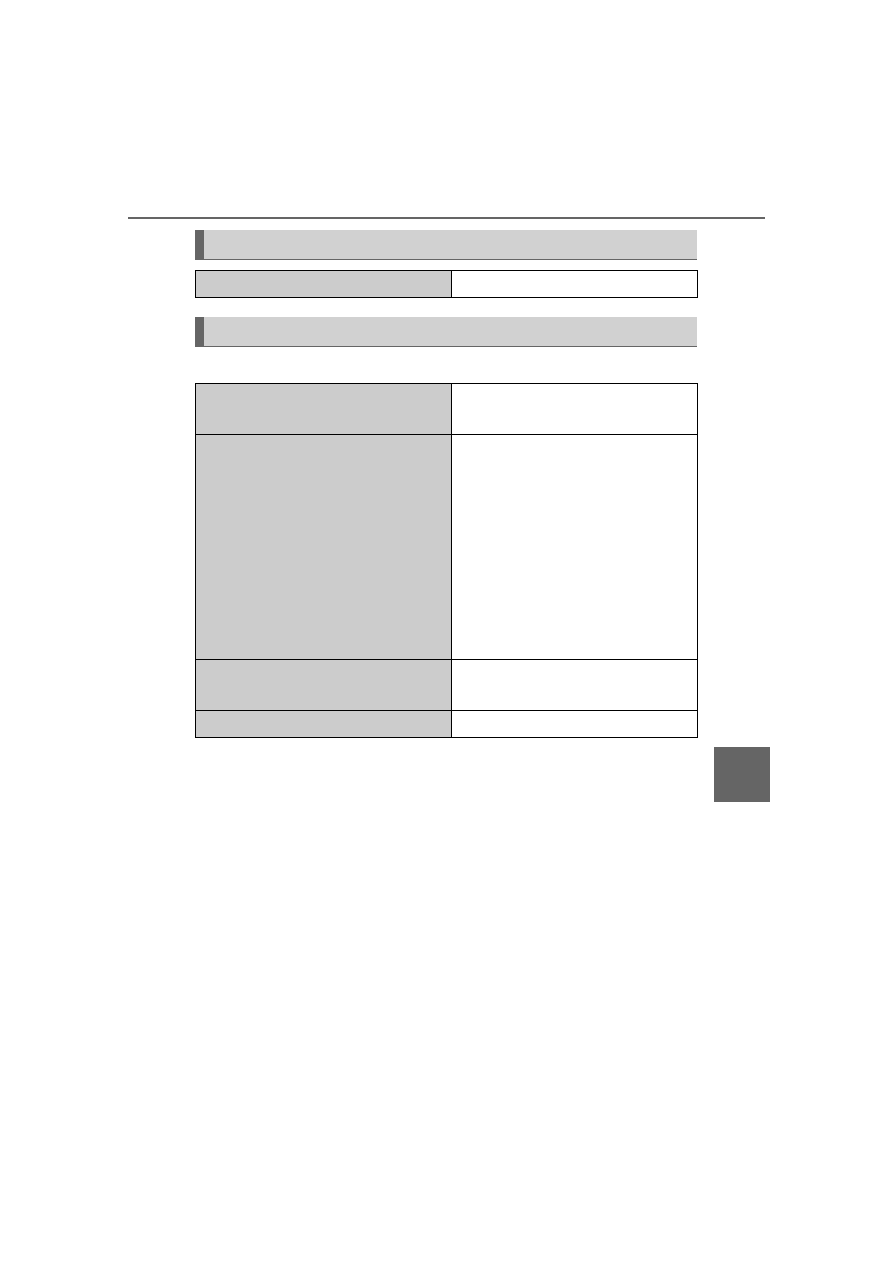
351
8-1. Specifications
8
Vehi
cle
spec
ifi
ca
tions
20-inch tires
Steering
Free play
Less than 1.2 in. (30 mm)
Tires and wheels
Tire size
Front tires: 245/45RF20 99Y
Rear tires: 275/40RF20 102Y
Tire inflation pressure
(Recommended cold tire inflation pressure)
Driving under normal conditions:
Front: 33 psi (230 kPa, 2.3 kgf/cm
2
or bar)
Rear: 33 psi (230 kPa, 2.3 kgf/cm
2
or bar)
Driving at high speeds (above 137 mph
[220 km/h]) (in countries where such
speeds are permitted by law):
Add 10 psi (70 kPa, 0.7 kgf/cm
2
or bar) to
the front tires and rear tires. Never exceed
the maximum cold tire inflation pressure
indicated on the tire sidewall.
Wheel size
Front wheels: 20
8 1/2J
Rear wheels: 20
9 1/2J
Wheel nut torque
103.3 ft•lbf (140 N•m, 14.3 kgf•m)
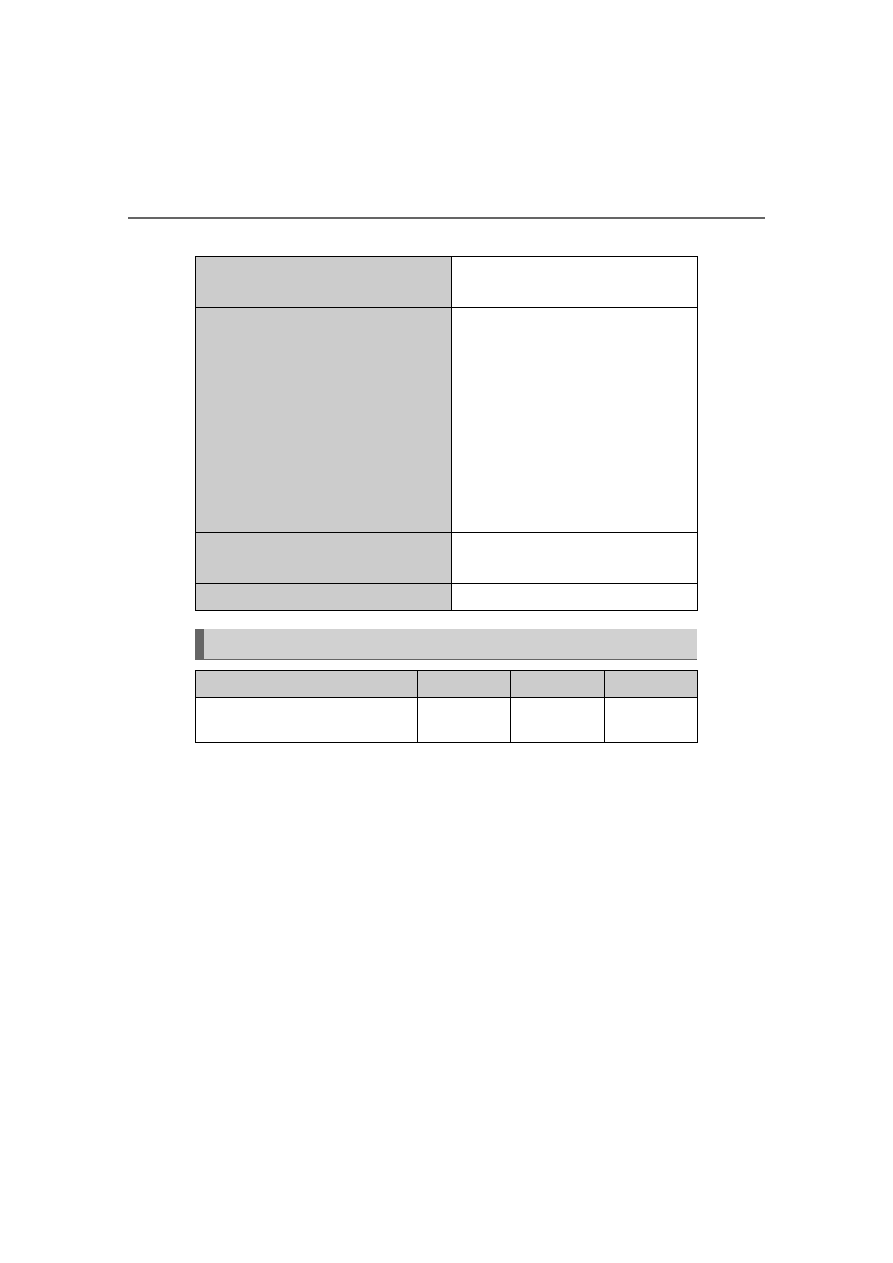
352
8-1. Specifications
21-inch tires
Tire size
Front tires: 245/40RF21 96Y
Rear tires: 275/35RF21 99Y
Tire inflation pressure
(Recommended cold tire inflation pressure)
Driving under normal conditions:
Front: 33 psi (230 kPa, 2.3 kgf/cm
2
or bar)
Rear: 33 psi (230 kPa, 2.3 kgf/cm
2
or bar)
Driving at high speeds (above 137 mph
[220 km/h]) (in countries where such
speeds are permitted by law):
Add 10 psi (70 kPa, 0.7 kgf/cm
2
or bar) to
the front tires and rear tires. Never exceed
the maximum cold tire inflation pressure
indicated on the tire sidewall.
Wheel size
Front wheels: 21
8 1/2J
Rear wheels: 21
9 1/2J
Wheel nut torque
103.3 ft•lbf (140 N•m, 14.3 kgf•m)
Light bulbs
Light bulbs
Bulb No.
W
Type
Vanity lights
2
Double end
bulbs
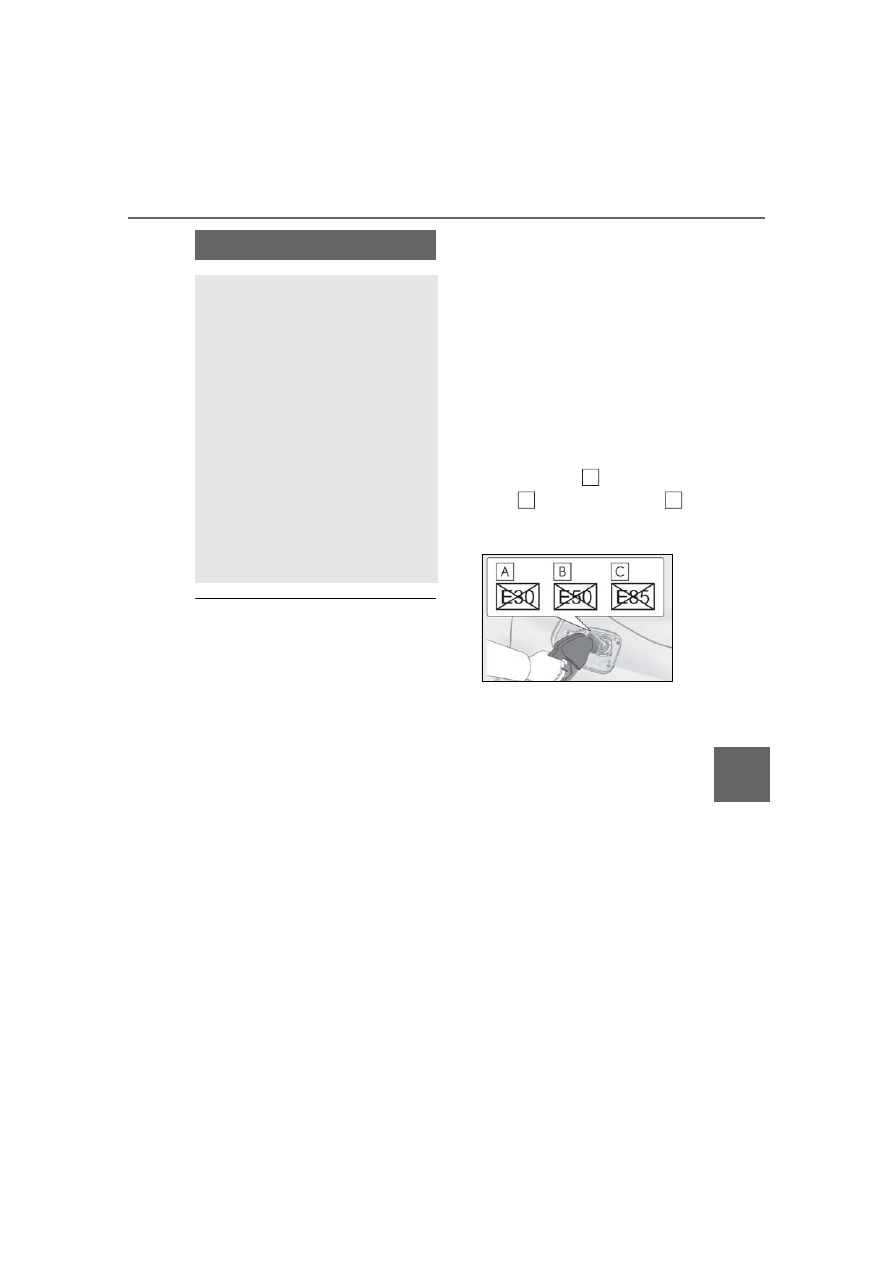
353
8-1. Specifications
8
Vehi
cle
spec
ifi
ca
tions
■
Gasoline quality
In very few cases, driveability problems may
be caused by the brand of gasoline you are
using. If driveability problems persist, try
changing the brand of gasoline. If this does
not correct the problem, consult your Lexus
dealer.
■
Recommendation of the use of gasoline
containing detergent additives
●
Lexus recommends the use of gasoline
that contains detergent additives to avoid
the build-up of engine deposits.
●
All gasoline sold in the U.S.A. contains
minimum detergent additives to clean
and/or keep clean intake systems, per
EPA’s lowest additives concentration
program.
●
Lexus strongly recommends the use of
Top Tier Detergent Gasoline. For more
information on Top Tier Detergent Gas-
oline and a list of marketers, please go to
the official website www.toptiergas.com.
■
Recommendation of the use of low
emissions gasoline
Gasolines containing oxygenates such as
ethers and ethanol, as well as reformulated
gasolines, are available in some cities.
These fuels are typically acceptable for use,
providing they meet other fuel require-
ments.
Lexus recommends these fuels, since the
formulations allow for reduced vehicle
emissions.
■
Non-recommendation of the use of
blended gasoline
●
Use only gasoline containing up to 15%
ethanol.
DO NOT use any flex-fuel or gasoline
that could contain more than 15% etha-
nol, including from any pump labeled
E30 (30% ethanol [
]), E50 (50%
ethanol [
]), E85 (85% ethanol [
])
(which are only some examples of fuel
containing more than 15% ethanol).
●
If you use gasohol in your vehicle, be sure
that it has an octane rating no lower than
91.
●
Lexus does not recommend the use of
gasoline containing methanol.
■
Non-recommendation of the use of gas-
oline containing MMT
Some gasoline contains an octane enhanc-
ing additive called MMT (Methylcyclopen-
tadienyl Manganese Tricarbonyl).
Lexus does not recommend the use of gas-
oline that contains MMT. If fuel containing
MMT is used, your emission control system
may be adversely affected.
The malfunction indicator lamp on the
instrument cluster may come on. If this hap-
pens, contact your Lexus dealer for service.
■
If your engine knocks
●
Consult your Lexus dealer.
●
You may occasionally notice light knock-
Fuel information
You must only use unleaded gaso-
line.
Select premium unleaded gasoline
with an octane rating of 91
(Research Octane Number 96) or
higher required for optimum
engine performance and fuel econ-
omy. If the octane rating is less than
91, damage to the engine may
occur and may void the vehicle
warranty.
At minimum, the gasoline you use
should meet the specifications of
ASTM D4814 in the U.S.A..
A
B
C
354
8-1. Specifications
ing for a short time while accelerating or
driving uphill. This is normal and there is
no need for concern.
NOTICE
■
Notice on fuel quality
●
Do not use improper fuels. If improper
fuels are used, the engine will be dam-
aged.
●
Do not use leaded gasoline.
Leaded gasoline can cause damage to
your vehicle’s three-way catalytic con-
verters causing the emission control
system to malfunction.
●
Do not use gasohol other than the type
previously stated.
Other gasohol may cause fuel system
damage or vehicle performance prob-
lems.
●
Using unleaded gasoline with an
octane number or rating lower than
the level previously stated may cause
persistent heavy knocking.
At worst, this may lead to engine dam-
age and will void the vehicle warranty.
■
Fuel-related poor driveability
If poor driveability (poor hot starting,
vaporization, engine knocking, etc.) is
encountered after using a different type
of fuel, discontinue the use of that type of
fuel.
■
When refueling with gasohol
Take care not to spill gasohol. It can
damage your vehicle’s paint.
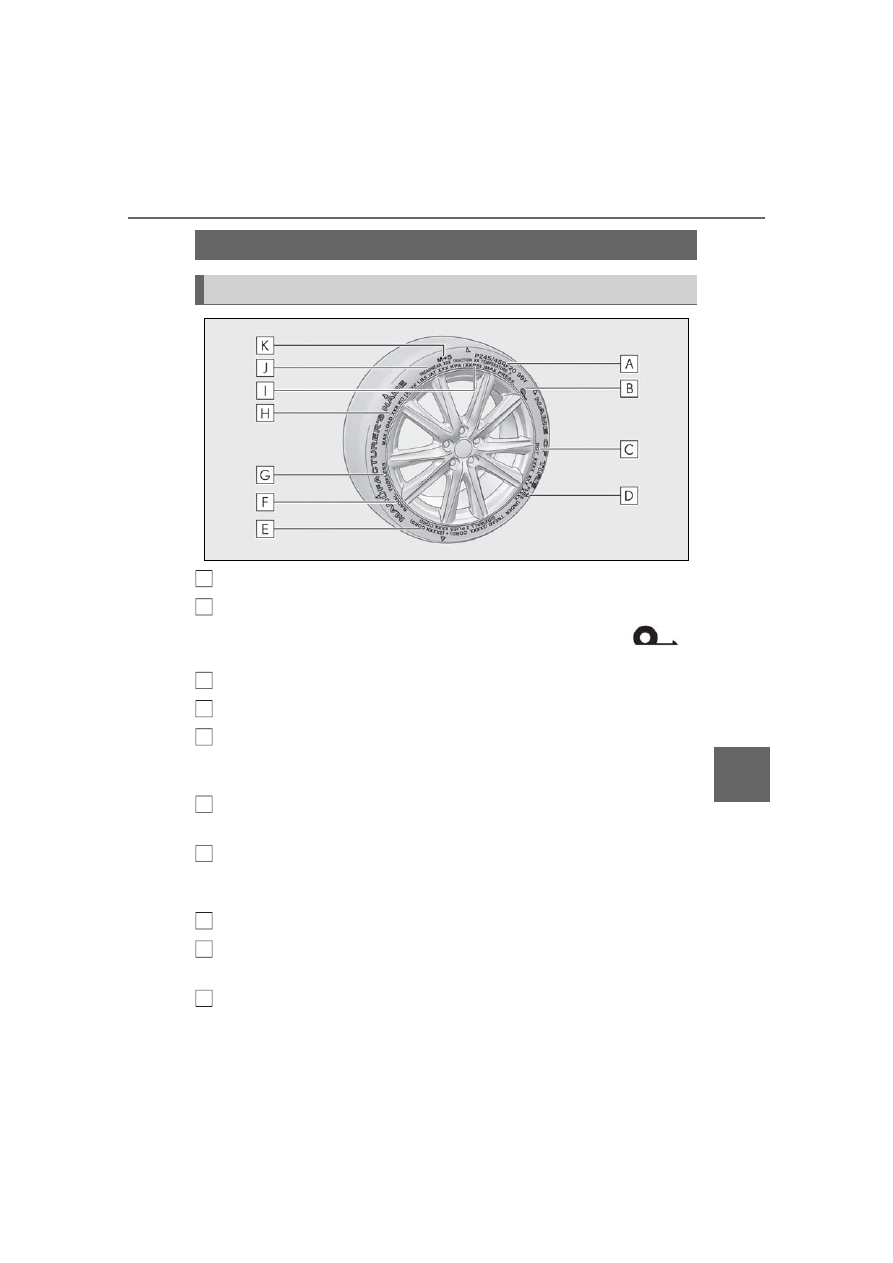
355
8-1. Specifications
8
Vehi
cle
spec
ifi
ca
tions
Tire size (
Run-flat tire (RFT) or standard tire (
This vehicle can be equipped with either run-flat tires (RFT) or standard tires. A
mark is molded on the sidewall of the run-flat tire.
DOT and Tire Identification Number (TIN) (
Location of treadwear indicators (
Tire ply composition and materials
Plies are layers of rubber-coated parallel cords. Cords are the strands which form the plies
in a tire.
Radial tires or bias-ply tires
A radial tire has “RADIAL” on the sidewall. A tire not marked “RADIAL” is a bias-ply tire.
TUBELESS or TUBE TYPE
A tubeless tire does not have a tube and air is directly put into the tire. A tube type tire has a
tube inside the tire and the tube maintains the air pressure.
Load limit at maximum cold tire inflation pressure (
Maximum cold tire inflation pressure (
This means the pressure to which a tire may be inflated.
Uniform tire quality grading
For details, see “Uniform Tire Quality Grading” that follows.
Tire information
Typical tire symbols
A
B
C
D
E
F
G
H
I
J
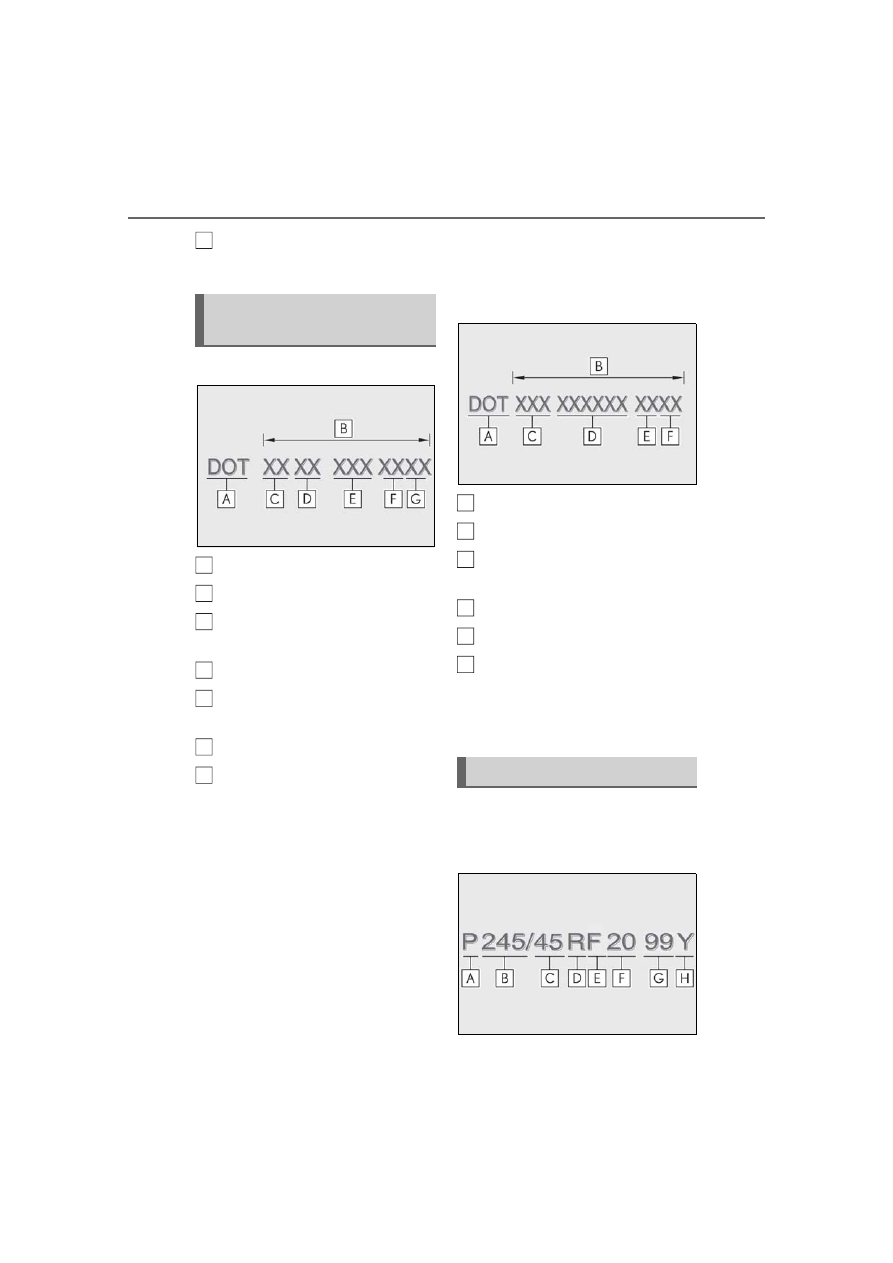
356
8-1. Specifications
Summer tires or all season tires (
An all season tire has “M+S” on the sidewall. A tire not marked “M+S” is a summer tire.
Type A
DOT symbol
*
Tire Identification Number (TIN)
Tire manufacturer’s identification
mark
Tire size code
Manufacturer’s optional tire type
code (3 or 4 letters)
Manufacturing week
Manufacturing year
*
: The DOT symbol certifies that the tire
conforms to applicable Federal Motor
Vehicle Safety Standards.
Type B
DOT symbol
*
Tire Identification Number (TIN)
Tire manufacturer’s identification
mark
Manufacturer’s code
Manufacturing week
Manufacturing year
*
: The DOT symbol certifies that the tire
conforms to applicable Federal Motor
Vehicle Safety Standards.
■
Typical tire size information
The illustration indicates typical tire
size.
K
Typical DOT and Tire Identifica-
tion Number (TIN)
A
B
C
D
E
F
G
Tire size
A
B
C
D
E
F
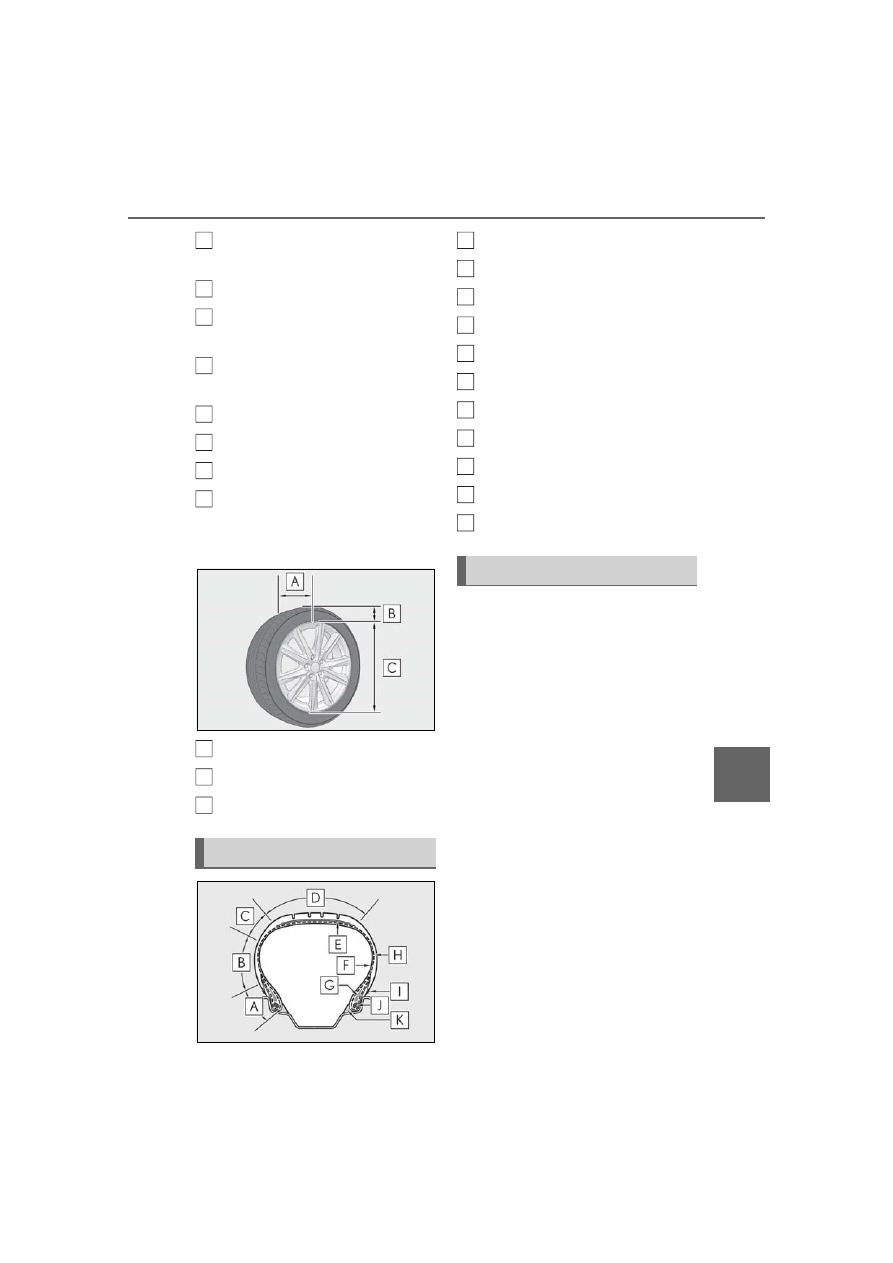
357
8-1. Specifications
8
Vehi
cle
spec
ifi
ca
tions
Tire use (P = Passenger car, T =
Temporary use)
Section width (millimeters)
Aspect ratio (tire height to section
width)
Tire construction code (R = Radial,
D = Diagonal)
Run-flat tire code
Wheel diameter (inches)
Load index (2 digits or 3 digits)
Speed symbol (alphabet with one
letter)
■
Tire dimensions
Section width
Tire height
Wheel diameter
Bead
Sidewall
Shoulder
Tread
Belt
Inner liner
Reinforcing rubber
Carcass
Rim lines
Bead wires
Chafer
This information has been prepared in
accordance with regulations issued by
the National Highway Traffic Safety
Administration of the U.S. Department
of Transportation.
It provides the purchasers and/or pro-
spective purchasers of Lexus vehicles
with information on uniform tire quality
grading.
Your Lexus dealer will help answer any
questions you may have as you read this
information.
■
DOT quality grades
All passenger vehicle tires must con-
form to Federal Safety Requirements
in addition to these grades. Quality
grades can be found where applicable
on the tire sidewall between tread
shoulder and maximum section width.
For example: Treadwear 200 Traction AA
Temperature A
Tire section names
A
B
C
D
E
F
G
H
A
B
C
Uniform Tire Quality Grading
A
B
C
D
E
F
G
H
I
J
K
358
8-1. Specifications
■
Treadwear
The treadwear grade is a comparative
rating based on the wear rate of the
tire when tested under controlled con-
ditions on a specified government test
course.
For example, a tire graded 150 would
wear one and a half (1 - 1/2) times as well
on the government course as a tire graded
100.
The relative performance of tires depends
upon the actual conditions of their use.
Performance may differ significantly from
the norm due to variations in driving habits,
service practices and differences in road
characteristics and climate.
■
Traction AA, A, B, C
The traction grades, from highest to
lowest, are AA, A, B and C, and they
represent the tire’s ability to stop on
wet pavement as measured under con-
trolled conditions on specified govern-
ment test surfaces of asphalt and
concrete.
A tire marked C may have poor traction
performance.
Warning: The traction grade assigned to
this tire is based on braking (straight
ahead) traction tests and does not include
cornering (turning) traction.
■
Temperature A, B, C
The temperature grades are A (the
highest), B, and C, representing the
tire’s resistance to the generation of
heat and its ability to dissipate heat
when tested under controlled condi-
tions on a specified indoor laboratory
test wheel.
Sustained high temperature can cause the
material of the tire to degenerate and
reduce tire life, and excessive temperature
can lead to sudden tire failure.
Grade C corresponds to a level of perfor-
mance which all passenger car tires must
meet under the Federal Motor Vehicle
Safety Standard No. 109.
Grades B and A represent higher levels of
performance on the laboratory test wheel
than the minimum required by law.
Warning: The temperature grades of a tire
assume that it is properly inflated and not
overloaded.
Excessive speed, underinflation, or exces-
sive loading, either separately or in combi-
nation, can cause heat buildup and
possible tire failure.
Glossary of tire terminology
Tire related term
Meaning
Cold tire inflation
pressure
Tire pressure when the vehicle has been parked for three hours or
more, or has not been driven more than 1 mile or 1.5 km under that
condition
Maximum inflation
pressure
The maximum cold inflated pressure to which a tire may be inflated,
shown on the sidewall of the tire
Recommended
inflation pressure
Cold tire inflation pressure recommended by a manufacturer
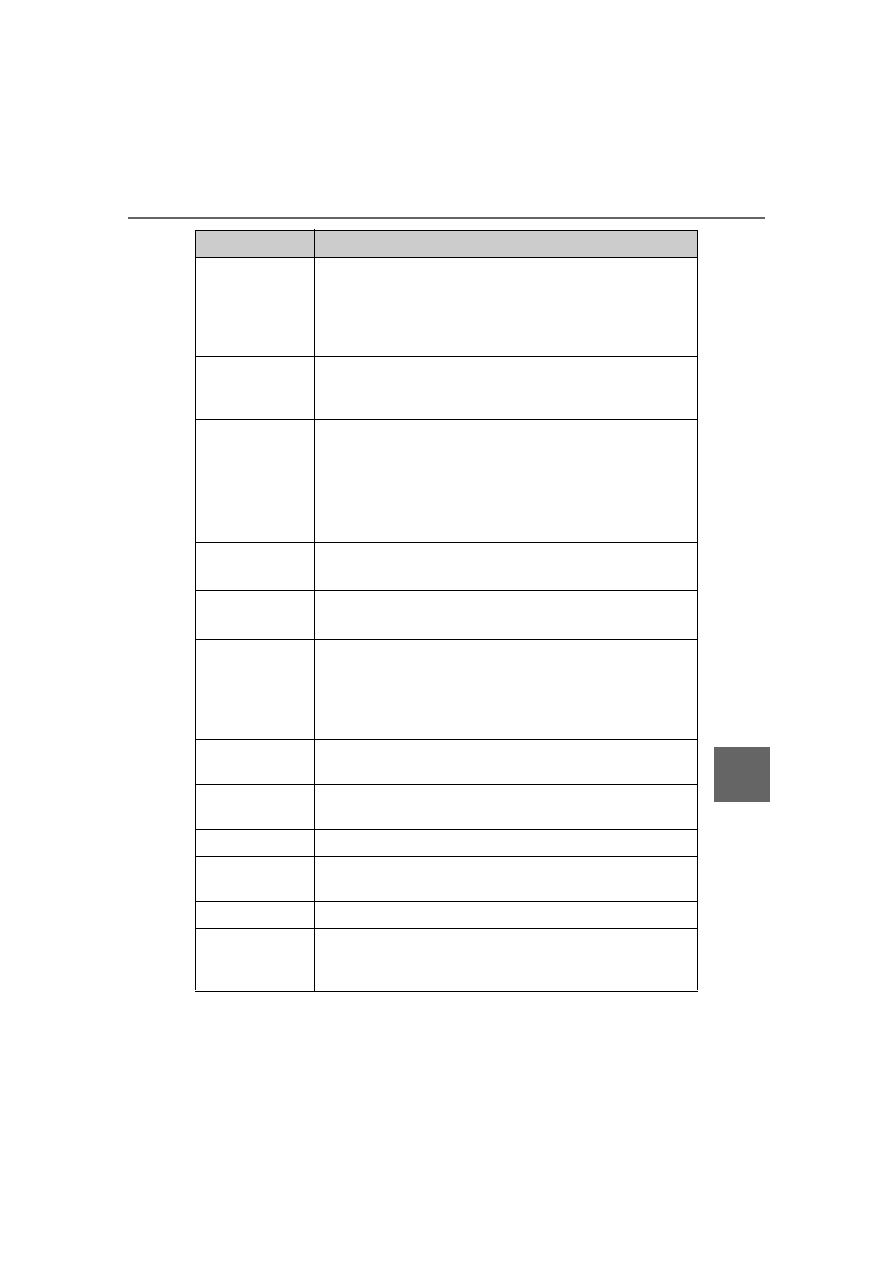
359
8-1. Specifications
8
Vehi
cle
spec
ifi
ca
tions
Accessory weight
The combined weight (in excess of those standard items which may
be replaced) of automatic transmission <hybrid transmission>, power
steering, power brakes, power windows, power seats, radio and
heater, to the extent that these items are available as factory-installed
equipment (whether installed or not)
Curb weight
The weight of a motor vehicle with standard equipment, including the
maximum capacity of fuel, oil and coolant, and if so equipped, air
conditioning and additional weight optional engine
Maximum loaded
vehicle weight
The sum of:
(a) Curb weight
(b) Accessory weight
(c) Vehicle capacity weight
(d) Production options weight
Normal occupant
weight
150 lb. (68 kg) times the number of occupants specified in the sec-
ond column of Table 1
*
that follows
Occupant distribu-
tion
Distribution of occupants in a vehicle as specified in the third column
of Table 1
*
below
Production options
weight
The combined weight of installed regular production options weigh-
ing over 5 lb. (2.3 kg) in excess of the standard items which they
replace, not previously considered in curb weight or accessory
weight, including heavy duty brakes, ride levelers, roof rack, heavy
duty battery, and special trim
Rim
A metal support for a tire or a tire and tube assembly upon which the
tire beads are seated
Rim diameter
(Wheel diameter)
Nominal diameter of the bead seat
Rim size designation Rim diameter and width
Rim type designa-
tion
The industry manufacturer’s designation for a rim by style or code
Rim width
Nominal distance between rim flanges
Vehicle capacity
weight (Total load
capacity)
The rated cargo and luggage load plus 150 lb. (68 kg) times the
vehicle’s designated seating capacity
Tire related term
Meaning

360
8-1. Specifications
Vehicle maximum
load on the tire
The load on an individual tire that is determined by distributing to
each axle its share of the maximum loaded vehicle weight, and divid-
ing by two
Vehicle normal load
on the tire
The load on an individual tire that is determined by distributing to
each axle its share of curb weight, accessory weight, and normal
occupant weight (distributed in accordance with Table 1
*
below),
and dividing by two
Weather side
The surface area of the rim not covered by the inflated tire
Bead
The part of the tire that is made of steel wires, wrapped or reinforced
by ply cords and that is shaped to fit the rim
Bead separation
A breakdown of the bond between components in the bead
Bias ply tire
A pneumatic tire in which the ply cords that extend to the beads are
laid at alternate angles substantially less than 90 degrees to the cen-
terline of the tread
Carcass
The tire structure, except tread and sidewall rubber which, when
inflated, bears the load
Chunking
The breaking away of pieces of the tread or sidewall
Cord
The strands forming the plies in the tire
Cord separation
The parting of cords from adjacent rubber compounds
Cracking
Any parting within the tread, sidewall, or innerliner of the tire extend-
ing to cord material
CT
A pneumatic tire with an inverted flange tire and rim system in which
the rim is designed with rim flanges pointed radially inward and the
tire is designed to fit on the underside of the rim in a manner that
encloses the rim flanges inside the air cavity of the tire
Extra load tire
A tire designed to operate at higher loads and at higher inflation
pressures than the corresponding standard tire
Groove
The space between two adjacent tread ribs
Innerliner
The layer(s) forming the inside surface of a tubeless tire that contains
the inflating medium within the tire
Innerliner separa-
tion
The parting of the innerliner from cord material in the carcass
Tire related term
Meaning
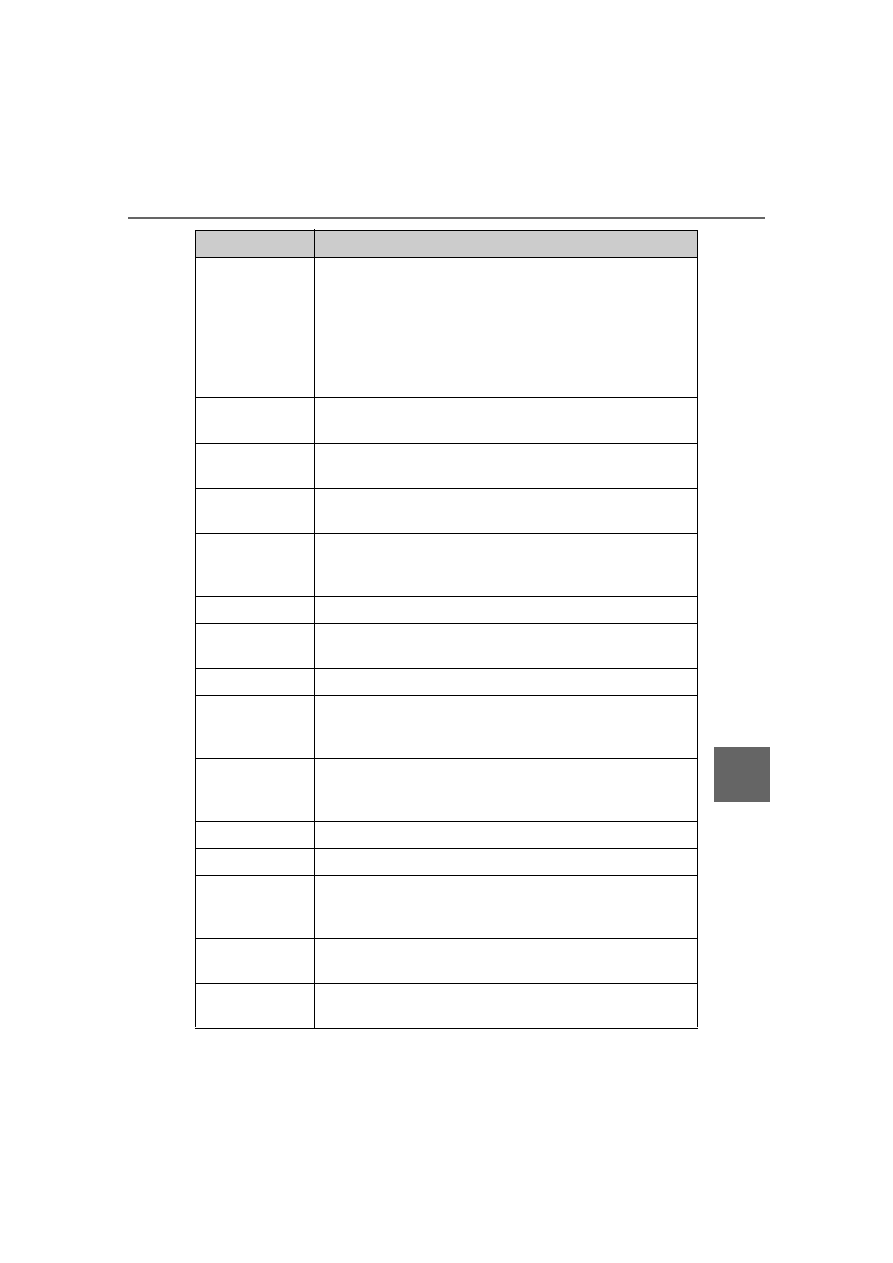
361
8-1. Specifications
8
Vehi
cle
spec
ifi
ca
tions
Intended outboard
sidewall
(a) The sidewall that contains a whitewall, bears white lettering, or
bears manufacturer, brand, and/or model name molding that is
higher or deeper than the same molding on the other sidewall of the
tire, or
(b) The outward facing sidewall of an asymmetrical tire that has a
particular side that must always face outward when mounted on a
vehicle
Light truck (LT) tire
A tire designated by its manufacturer as primarily intended for use
on lightweight trucks or multipurpose passenger vehicles
Load rating
The maximum load that a tire is rated to carry for a given inflation
pressure
Maximum load rat-
ing
The load rating for a tire at the maximum permissible inflation pres-
sure for that tire
Maximum permissi-
ble inflation pres-
sure
The maximum cold inflation pressure to which a tire may be inflated
Measuring rim
The rim on which a tire is fitted for physical dimension requirements
Open splice
Any parting at any junction of tread, sidewall, or innerliner that
extends to cord material
Outer diameter
The overall diameter of an inflated new tire
Overall width
The linear distance between the exteriors of the sidewalls of an
inflated tire, including elevations due to labeling, decorations, or pro-
tective bands or ribs
Passenger car tire
A tire intended for use on passenger cars, multipurpose passenger
vehicles, and trucks, that have a gross vehicle weight rating (GVWR)
of 10,000 lb. or less.
Ply
A layer of rubber-coated parallel cords
Ply separation
A parting of rubber compound between adjacent plies
Pneumatic tire
A mechanical device made of rubber, chemicals, fabric and steel or
other materials, that, when mounted on an automotive wheel, pro-
vides the traction and contains the gas or fluid that sustains the load
Radial ply tire
A pneumatic tire in which the ply cords that extend to the beads are
laid at substantially 90 degrees to the centerline of the tread
Reinforced tire
A tire designed to operate at higher loads and at higher inflation
pressures than the corresponding standard tire
Tire related term
Meaning

362
8-1. Specifications
*
: Table 1
Occupant loading and distribution for vehicle normal load for various desig-
nated seating capacities
Section width
The linear distance between the exteriors of the sidewalls of an
inflated tire, excluding elevations due to labeling, decoration, or pro-
tective bands
Sidewall
That portion of a tire between the tread and bead
Sidewall separation
The parting of the rubber compound from the cord material in the
sidewall
Snow tire
A tire that attains a traction index equal to or greater than 110, com-
pared to the ASTM E-1136 Standard Reference Test Tire, when
using the snow traction test as described in ASTM F-1805-00, Stan-
dard Test Method for Single Wheel Driving Traction in a Straight
Line on Snow-and Ice-Covered Surfaces, and which is marked with
an Alpine Symbol (
) on at least one sidewall
Test rim
The rim on which a tire is fitted for testing, and may be any rim listed
as appropriate for use with that tire
Tread
That portion of a tire that comes into contact with the road
Tread rib
A tread section running circumferentially around a tire
Tread separation
Pulling away of the tread from the tire carcass
Treadwear indica-
tors (TWI)
The projections within the principal grooves designed to give a visual
indication of the degrees of wear of the tread
Wheel-holding fix-
ture
The fixture used to hold the wheel and tire assembly securely during
testing
Designated seating capacity,
Number of occupants
Vehicle normal load, Num-
ber of occupants
Occupant distribution in a
normally loaded vehicle
2 through 4
2
2 in front
5 through 10
3
2 in front, 1 in second seat
11 through 15
5
2 in front, 1 in second seat, 1 in
third seat, 1 in fourth seat
16 through 20
7
2 in front, 2 in second seat, 2
in third seat, 1 in fourth seat
Tire related term
Meaning

Нет комментариевНе стесняйтесь поделиться с нами вашим ценным мнением.
Текст